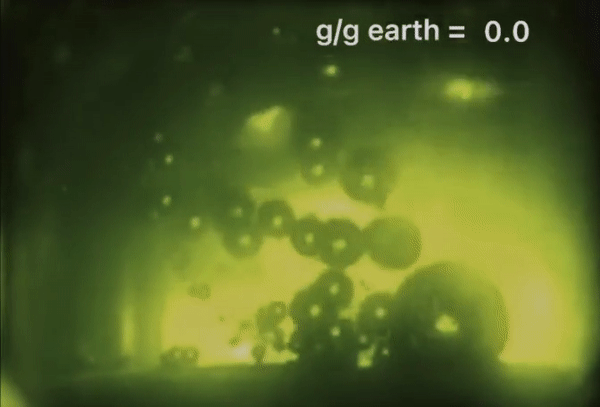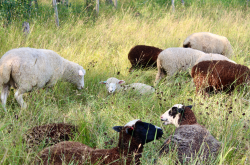3 Things you should know about using the same farmland for producing crops AND solar energy, museum conservators’ superhuman “vision,” and making french fries in space

Meet Cassandra Marion, Renée-Claude Goulet, and Michelle Campbell Mekarski.
They are Ingenium’s science advisors, providing expert scientific advice on key subjects relating to the Canada Aviation and Space Museum, the Canada Agriculture and Food Museum, and the Canada Science and Technology Museum.
In this colourful monthly blog series, Ingenium’s science advisors offer up interesting and sometimes quirky nuggets related to their areas of expertise. For this July edition, Michelle Campbell Mekarski has invited Jacqueline Riddle — a Conservator at Ingenium — to fill in. Collectively, our experts explain how future astronauts may be able to cook french fries in space, how technology gives museum conservators superhuman “vision,” and how the same farmland can be used to grow food crops and to “harvest” electricity from solar energy.
Harvesting crops and solar energy on the farm: part of the net-zero future?
What if we could "double-dip" on land, growing crops AND converting the Sun's energy into electricity, at the same time?
Canada is one of many countries worldwide that have committed to reaching "net-zero," or carbon neutrality, by 2050. To do so, we will need to quickly and creatively deploy existing technologies to replace fossil fuel-burning power generation.

Solar panels mounted high above crops provide micro-environments that can help plants grow better, all while producing electricity.
Capturing solar energy through solar panels is a proven way to meet our needs for electricity, but we lack appropriate places to put these solar “power plants." Currently, a solar panel can convert only about 17 to 20 percent of the energy received from the Sun into electricity. Because of this, solar farms require large tracts of land with full access to sunlight to produce significant amounts of electricity. There is lots of competition for access to this land, and we have to balance society's needs for power generation infrastructure, agriculture, housing, and preserving natural areas. So, aside from integrating solar panels into buildings and rooftops in a piecemeal approach, another option exists: combining solar farms with conventional farms, giving us "agrivoltaics."
Researchers at Western University in London, Ontario, have been examining the potential for this idea here in Canada, a country with a lot of sunny agricultural land, especially in the prairie provinces, which get the most sunlight.
If you have ever seen a solar farm as they are today, you may have noticed that the panels are installed quite closely together, and low to the ground, making the space underneath unusable. But, maybe not completely unusable, as grass and wild plants still grow, and need to be kept under control. Some solar farming companies have partnered with sheep farmers to get their "living mowers" grazing under the solar panels to keep the vegetation in check, with very low human labour and with no specialized equipment or machines. This practise is dubbed "solar grazing."
So, what would a solar crop farm look like? Since plants require light to grow, it wouldn't make much sense to install panels low to the ground as on a typical solar farm. The installation also needs to accommodate heavy machinery such as tractors, seeders, sprayers, and harvesters. To solve this, engineers all over the world are developing special racking, or mounting, systems. These elevate solar panels to a height that allows work to happen underneath. The panels are also mounted at the optimal angle to catch the most sunlight, and they may also track the Sun as it moves across the sky.
Installed this way, solar panels don't block the light completely, and can help some crops grow better. The shading provided by the panels creates micro-environments where water evaporates more slowly, meaning crops require less water. Some crops get too much sunlight, and benefit from growing in the partial shade of solar panels. Research needs to continue to determine which of the Canadian-grown crops are the best candidates for this system.
For farmers, there could be important economical benefits to integrating solar panels on their farms. Higher yields of shade-tolerant crops could help boost income. And electricity generated by the solar panels can not only meet the energy needs of the farm’s activities and buildings, but also bring in extra income if the surplus electricity is sold into power the grid. An additional benefit of solar panels in fields is protection from hail, heavy rains, and winds that can damage crops and cause soil erosion.
Like any technology, it is not without its drawbacks. Installing a solar farm is a hefty investment for farmers who might also have to contend with zoning laws and local politics. As previously mentioned, solar panels are not yet very efficient, and have a lifespan of about 20 years. These limitations lead to the question of the environmental impacts of the full lifecycle of the technology, from mining the silicon needed to make the cells, to the energy that goes into creating and transporting the panels, and to what happens to the materials after the operational life is done.
Interestingly, according to calculations, only a small percentage of farms would need to be converted to cover all our fossil-fuel burning electricity needs! The idea of agrivoltaics is certainly not mainstream yet in Canada, but it's important to recognize that innovative solutions and ideas like this one can all be part of the puzzle on our path to eliminating fossil-fuel use and carbon emissions.
Go further:
Learn more about agrivoltaics research and the Western Innovation for Renewable Energy Deployment (WIRED) open-source outdoor photovoltaics testing centre
https://www.appropedia.org/Western_Innovation_for_Renewable_Energy_(WIRED)
Canada's net zero future and the technologies needed to achieve this goal https://climateinstitute.ca/reports/canadas-net-zero-future/
By Renée-Claude Goulet

A micrograph of hairy tarantula feet at 40x magnification, taken with a Nikon Eclipse Polarizing Microscope, from the Hidden Worlds Online Exhibition.
How conservators are (kind of) like Superman
Conservators are tasked with the long-term preservation of artifacts in the museum collection, and we accomplish this using many methods. Working at the intersection of science, art, history, and engineering, we often borrow and adapt technologies from other disciplines and use them to uncover more information about artifacts. One of the tools in our toolbox is conservation imaging. Much like Superman, we use infrared, microscopic, and x-ray vision to support our work. But instead of using our superhuman “vision” to fight villains, we use it to reveal secrets of historic artifacts that are invisible to the naked eye.
An example of conservation imaging is the Hidden Worlds Online Exhibition at the Canada Science and Technology Museum. To make this exhibition, conservators used a polarised light microscope to take close up pictures (micrographs) of these collection artifacts, which allow online visitors to see monitor lizard skin, goose barnacle tentacles, and hairy tarantula legs up close in delightful (albeit grisly) detail, just like Superman would. Having these close-up images also allows us to assess the condition of these artifacts over time, as conservators can compare what they see under the microscope today to past micrographs.

Signage outside the X-ray room at the Canadian Conservation Institute, Ottawa.
But conservators are not satisfied to just see artifacts up close. We also use x-radiography – just like Superman’s x-ray vision – to see inside and assess the condition of artifacts that cannot be easily opened. Recently, conservators at the Canada Aviation and Space Museum partnered with the Canadian Conservation Institute (CCI) to use x-radiography to assess the condition of spare tires for the Lancaster Bomber. This is the latest in a series of x-radiography joint projects with CCI, which have allowed us see the bowels of artifacts such as farm animal toy Milky the Marvelous Milking Cow.
Conservators also use part of the other side of the electromagnetic spectrum, infrared light, to investigate artifacts. Infrared imaging technology was originally used for military applications starting in World War II. Conservators of paintings now use infrared photography and infrared reflectography to distinguish different pigment types and carbon-based underdrawings below the painted surface. These tools allow conservators to better understand artistic processes, and can inform their conservation treatments.
So that’s how conservators are (kind of) like Superman: we use X-ray “vision” and other unique imaging tools to do our jobs. Unfortunately, we can’t fly and don’t have superhuman strength…yet.
By Jacqueline Riddle
Space Fries! Can We Fry Food in Microgravity?
A healthy and nutritious diet is essential for an astronaut in space, but enjoying that food is an essential part of crew moral on any space mission. Space food has come a long way, from applesauce in a tube to flavourful shrimp cocktail or spaghetti served in a sachet. With humans soon venturing into deep space, researchers are looking for new ways to add variety and help astronauts enjoy mealtimes.
What about the ultimate comfort food, French fries?
New research supported by the European Space Agency suggests making fries in space is possible!
The experiment was run on two separate parabolic flights – where an aircraft flies in a series of arcs to simulate periods of weightlessness or the gravity on different celestial bodies. A closed carousel-type pressurized apparatus was constructed to safely contain and efficiently heat the oil and add uncooked potatoes. High speed cameras captured video of the frying process, including the size and growth rate of the bubbles as well as their speed; and thermometers recorded both the temperature of the oil and potatoes.
On Earth, vapour bubbles rise in boiling fluids causing fluid circulation or heat convection which is essential in the frying process, where the oil needs to continue to flow across the surface of the potato to achieve that crispy exterior. One would think that in a low gravity environment, convection would be inefficient and the bubbles would stick to the potato rather than move along it, which would produce uncooked fries.

Steam bubbles in frying oil captured with high speed cameras during a parabolic flight.
It came as a pleasant surprise that, soon after the potatoes were added to the oil, the vapour bubbles detached from the surface of the potato, as they should in a convecting fluid, which strongly suggests, frying foods in microgravity is possible.
Though fried foods score poorly in the health and nutrition department, particularly in terms of cardiovascular health, they could offer a comforting treat to a hard-working homesick astronaut. But is frying a practical method of food preparation in space? A hot oil leak would result in a nightmare scenario in microgravity, though perhaps a fry stand on the surface of the Moon or Mars could be reasonable?
This experiment does however, come with the added benefit of better understanding how boiling fluids behave in space, not just those used for cooking. And of course, there are other ways of adding variety and comfort to one’s space diet, such as fresh foods grown in space.
By Cassandra Marion
Enjoying the Ingenium Channel? Help us improve your experience with a short survey!
















